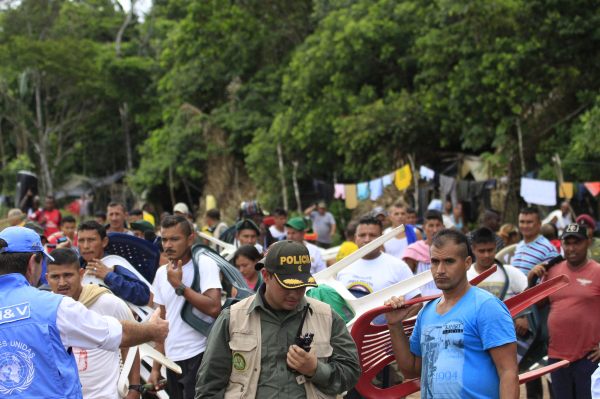By Nazih Richani*

A FARC demobilization zone is visited by the UN Security Council Field Mission. / UK Mission to the UN / Lorey Campese / Flickr / Creative Commons
The Colombian peace accord has achieved another historic landmark, but the process has been anything but easy – and continues to face serious impediments. The Revolutionary Armed Forces of Colombia (FARC) have deposited 60 percent of their weapons in UN containers to be destroyed, a watershed in the history of Colombia, as the 53-year-old insurgent group enters a new phase. A coalition of political and social groups, however, continues efforts to stymie implementation of the accord. It includes large landowners, cattle ranchers, agribusinesses, ultra-right religious groups, and extractive multinational corporations. Its leading spokesmen are former President Álvaro Uribe and former Attorney General Alejandro Ordóñez, who are spearheading a vigorous campaign arguing that President Juan Manuel Santos and his government conceded too much to the FARC, compromising private property rights, the prevailing land-tenure system, and the country’s Christian values. (The official line of the Colombian Catholic Church, which has strongly conservative factions, has been “neutral” on the peace accord, although Pope Francis has expressed strong support for it.)
These forces have flexed their muscles before. They were instrumental in mobilizing opposition to the referendum on the accord last October, which forced the government to incorporate their demands by making the language of the accord clear that property rights and the agribusiness-extractive-rentier economic model remained dominant. The opposition remains on the offensive, this time using the Public Prosecutor’s Office and the Constitutional Court. While Public Prosecutor Nestor Humberto Martínez was going after FARC money, alleging that the rebels did not declare all their assets, the Constitutional Court challenged the “Fast-Track” process by which passage of bills related to implementation of the peace accord could be accelerated by reducing the number of parliamentary debates and the time required for approval. This opened the door for the opposition coalition in parliament to challenge the accord repeatedly with protracted debate and amendments. Its main goal has been to prevent any change in the rural land tenure system and block the inclusion of the FARC in the political process.
The opponents’ ability to tip the political balance against the accord is likely to grow as Colombia prepares for its presidential election in May 2018. The Santos government, the left, and center-left have already looked weak while trying to make even modest reforms necessary to create conditions for a lasting peace and facilitating a transition from a war system political economy to a different one. The paramilitaries, including old groups that remained operative after the formal demobilization of 2005-06 (such as the “Urabeños,” mutated from the former United-Defense Forces, AUC); the drug cartels and organized crime; the dramatic expansion of coca plantations; and mining of dubious legality are important components of the “old” war system that are still potent and fuel the reactionary coalition. The exit of the FARC (and possibly the National Liberation Army, ELN, as well) are certain to change the composition and political economy of the war system that has shaped Colombia for more than four decades, but new actors (the Urabeños and others) are emerging and mutations are taking place. These forces will persist and wield considerable power as long as Colombia is not willing or capable of addressing the country’s need for agrarian reforms and pursuing sustainable economic development based on a more equitable distribution of wealth and income.
June 27, 2017
* Nazih Richani is an Associate Professor of Political Science and Director of Latin American Studies at Kean University. In 2014, the State University of New York Press published a revised and updated version of his 2002 study entitled Systems of Violence: The Political Economy of War and Peace in Colombia.
